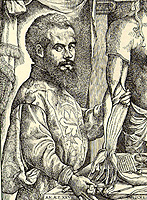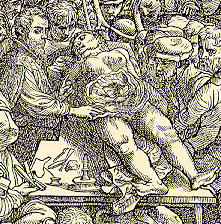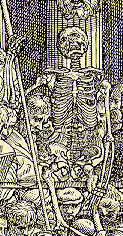
VESALIUS THE HUMANIST
 Modern medicine
began in 1543 with the publication of the first complete textbook of human
anatomy, De Humanis Corporis Fabrica by Andreas Vesalius (1514-1564, pictured at
right). Vesalius can only be compared with Hippocrates in stature and
importance. The great anatomist was a classicist by education. He knew Greek and
Latin to perfection. He zealously studied the ancient authors and extolled them.
In this sense, Vesalius was a humanist.
Modern medicine
began in 1543 with the publication of the first complete textbook of human
anatomy, De Humanis Corporis Fabrica by Andreas Vesalius (1514-1564, pictured at
right). Vesalius can only be compared with Hippocrates in stature and
importance. The great anatomist was a classicist by education. He knew Greek and
Latin to perfection. He zealously studied the ancient authors and extolled them.
In this sense, Vesalius was a humanist.
The De Fabrica is composed in Latin. Hardly any scientist of the sixteenth
century would have presented his findings in the vernacular. But Vesalius
renounced the Latin that was spoken and written by scholars of his time; he
purified the common stock of words; he abandoned the simple colloquial prose
style, the logical sequence of thought characteristic of the scientific
literature of that period. Instead, Vesalius reintroduced the terminology of a
time long past. He adopted a stately rhythmical style, a rhetorical word order,
in short, he imitated the periodic Latin, the Kunstprosa or “artistic prose” of
Cicero, and he was the first anatomist to do so.
The Classical Latin style in which Vesalius ventured to formulate his
findings made it rather difficult for the average physician of his day to
understand the content of the De Fabrica. Many a contemporary reader must have
wondered why Vesalius took this risk; he must have found it meaningless if not
counterproductive, that the great anatomist should have labored to veil his
empirical investigations in the garb of so artificial a language. Yet Vesalius
believed that by recovering true and correct speech the road was paved for the
recovery of true and correct knowledge. Thus, the resurrection of anatomy could
only occur hand in hand with the rebirth of the Classics.
However revolutionary Vesalius’ achievement may seem to the modern historian,
for him it was only the revival of the work of ancient anatomists. Anatomy,
according to Vesalius, “should be recalled from the dead, so that if it did
not achieve with us a greater perfection that at any other place or time among
the old teachers of anatomy, it might at least reach such a point that one could
with confidence assert that our modern science of anatomy was equal to that of
old, and that in this age anatomy was unique both in the level to which it had
sunk and in the completeness of its subsequent restoration” (De Fabrica,
praefatio, 3r, ll.22ff).
And he rejoices because “there is no ground for hope that anatomy will ere
long be cultivated in all our academies as it was of old in Alexandria” (De
Fabrica, praefatio, 3v, ll.30ff.). The slogan of the humanist school of which
Vesalius was a part was: “The truth was long since found, and has united
noble spirits, do but grasp the ancient truth”. Once the Greeks had been in
possession of the truth; now truth and perfection were reborn, they came to
light again. This is the way in which Humanists viewed the contemporary
development of art and literature during the Renaissance. Vesalius extended this
humanism to include anatomy. He knew from Cicero and Celsus that the ancients
had dissected human bodies; he learned from Galen that Alexandria had been the
center of anatomical research. Modern anatomy was indeed the resurrection of
ancient anatomy.
 The images shown here are details taken from the frontispiece of the
1555 edition of De Fabrica in all probability designed by Johannes
Stephan van Calcar, a pupil of Titian. The plate exerted enormous influence
because this plate, besides being a good work of art, also illustrated a
striking scientific manifestation. Thus this woodcut became one of the renowned
medical prints. It shows how Vesalius went to work at his lectures on anatomy.
The bearded figure of the anatomist stands in the middle beside the dissecting
table,
The images shown here are details taken from the frontispiece of the
1555 edition of De Fabrica in all probability designed by Johannes
Stephan van Calcar, a pupil of Titian. The plate exerted enormous influence
because this plate, besides being a good work of art, also illustrated a
striking scientific manifestation. Thus this woodcut became one of the renowned
medical prints. It shows how Vesalius went to work at his lectures on anatomy.
The bearded figure of the anatomist stands in the middle beside the dissecting
table,  surrounded by a crowd, about 70 strong, of students and
spectators of all ages, while he himself is performing the autopsy on the
cadaver of a woman. The detailed treatment of the skeleton in the middle is
allusive to Vesalius’ habit of using a skeleton to illustrate his lectures.
surrounded by a crowd, about 70 strong, of students and
spectators of all ages, while he himself is performing the autopsy on the
cadaver of a woman. The detailed treatment of the skeleton in the middle is
allusive to Vesalius’ habit of using a skeleton to illustrate his lectures.
It is noteworthy that neither Asclepius nor his rod-and-serpent is depicted
in the frontispiece of the De Fabrica. Although Vesalius believed modern anatomy
was the resurrection of Classical anatomy, he considered himself a scientific
“progressive” and was not particularly enamored of the magical, miraculous cures
of Asclepius’ cult and felt no need of a medical symbol the origin and meaning
of which he must have considered dubious.

Byzantine
Medicine  The images shown here are details taken from the frontispiece of the
1555 edition of De Fabrica in all probability designed by Johannes
Stephan van Calcar, a pupil of Titian. The plate exerted enormous influence
because this plate, besides being a good work of art, also illustrated a
striking scientific manifestation. Thus this woodcut became one of the renowned
medical prints. It shows how Vesalius went to work at his lectures on anatomy.
The bearded figure of the anatomist stands in the middle beside the dissecting
table,
The images shown here are details taken from the frontispiece of the
1555 edition of De Fabrica in all probability designed by Johannes
Stephan van Calcar, a pupil of Titian. The plate exerted enormous influence
because this plate, besides being a good work of art, also illustrated a
striking scientific manifestation. Thus this woodcut became one of the renowned
medical prints. It shows how Vesalius went to work at his lectures on anatomy.
The bearded figure of the anatomist stands in the middle beside the dissecting
table,  surrounded by a crowd, about 70 strong, of students and
spectators of all ages, while he himself is performing the autopsy on the
cadaver of a woman. The detailed treatment of the skeleton in the middle is
allusive to Vesalius’ habit of using a skeleton to illustrate his lectures.
surrounded by a crowd, about 70 strong, of students and
spectators of all ages, while he himself is performing the autopsy on the
cadaver of a woman. The detailed treatment of the skeleton in the middle is
allusive to Vesalius’ habit of using a skeleton to illustrate his lectures.

 Modern medicine
began in 1543 with the publication of the first complete textbook of human
anatomy, De Humanis Corporis Fabrica by Andreas Vesalius (1514-1564, pictured at
right). Vesalius can only be compared with Hippocrates in stature and
importance. The great anatomist was a classicist by education. He knew Greek and
Latin to perfection. He zealously studied the ancient authors and extolled them.
In this sense, Vesalius was a humanist.
Modern medicine
began in 1543 with the publication of the first complete textbook of human
anatomy, De Humanis Corporis Fabrica by Andreas Vesalius (1514-1564, pictured at
right). Vesalius can only be compared with Hippocrates in stature and
importance. The great anatomist was a classicist by education. He knew Greek and
Latin to perfection. He zealously studied the ancient authors and extolled them.
In this sense, Vesalius was a humanist.
